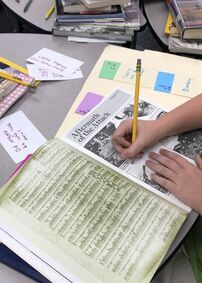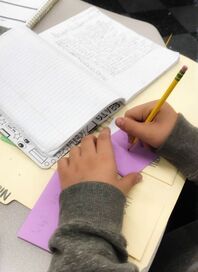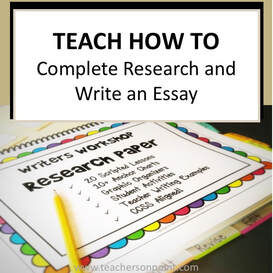|
I remember when I first decided that I wanted to teach my 5th graders how to conduct research in order to write a 5 paragraph essay. I was overwhelmed with where to even start! I know that kids are highly motivated when they have choice and are excited about their learning, and so I knew it would be important for each child to choose their own topic of study. Even though I would be modeling each step along the way, I did not want to assign them their topic. To guide students in choosing a topic, I always tell them a subject to choose a topic from. For example, for years, I had students choose a state they wanted to research while I modeled researching Alaska. For the first time this school year, I asked students to choose a topic related to WWII while I model with Japanese Internment Camps. I feel this gives them a sense of interest and independence when they are able to choose for themselves what topic they will be spending their time digging through books and talking about with experts. When creating a process for conducting research, I also wanted to provide students with a list of steps that they could use later on in middle, high school and even college. The steps had to be simple enough to work for any topic and any level of topic. So it had to be simple, but also have potential for students to gather lots of information. (click below to read more) Below are the 6 Steps to Research  1. Decide on the Topic I provide structure of choice by assigning a subject such as a state or topic related to a time period in history. This is helpful for when you are modeling steps 2 and 3. 2. List the Questions you want to Answer about your Topic I usually tell the students to come up with at least 20 questions. The more questions they have, the easier it will be to write the 5 paragraph essay. Also, I remind students to ask open-ended questions and to start with who, what, why, when, and how. No "yes" or "no" questions. 3. Categorize your Questions This step can be a little difficult for students if their questions are very basic or if they have less than 20. I sometimes will support students by discussing with them which categories they want to include (tell them to choose at least 4) and then list the questions. Reversing steps 2 and 3 helps those who are stuck on creating questions that will provide a decent amount of information. 4. Answer all of the Questions At this step, I have students create Research Collection Folders in order to ORGANIZE all of this information. Each file folder uses library card pockets to hold the color-coded index cards. Each pocket is a category and on each separate index card, students write their questions on one side. Afterwards, students write the information they find that pertains to the questions they asked.  5. Add New Information to the Categories I suggest for students to choose the categories that are most interesting to them and read about it in their books then jot down any interesting new facts they learned. If you would like to implement this into your teaching, purchase the entire 4 week unit (if you teach writing everyday) which includes over 100 pages of scripted lessons that follow a Writing Workshop model, anchor charts, teacher writing examples so you can model for your students the mini-lessons, conferencing tips and more!
0 Comments
Leave a Reply. |
Julia GrahamDaughter of the King, wife and mother, former upper elementary teacher, curriculum and course developer Archives
March 2023
Categories
All
|
Pages |
Resources |
|



 RSS Feed
RSS Feed